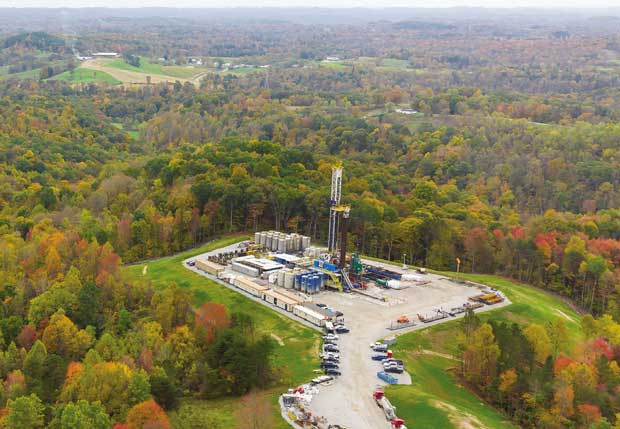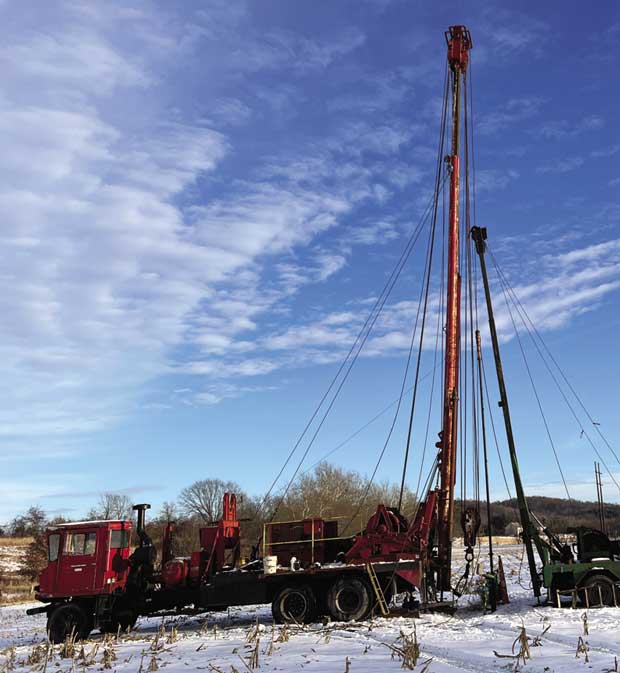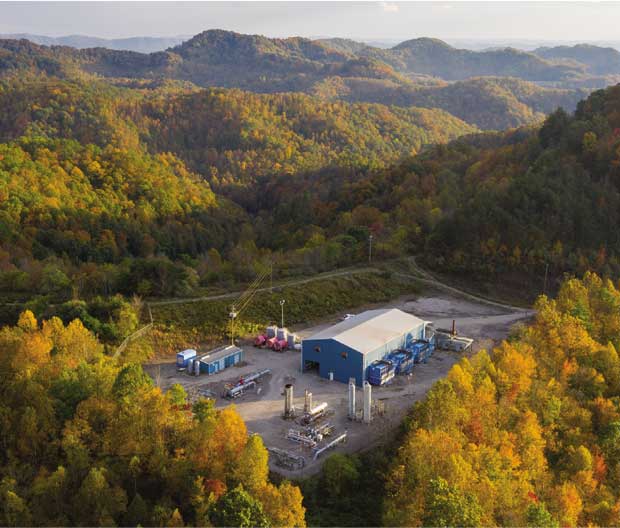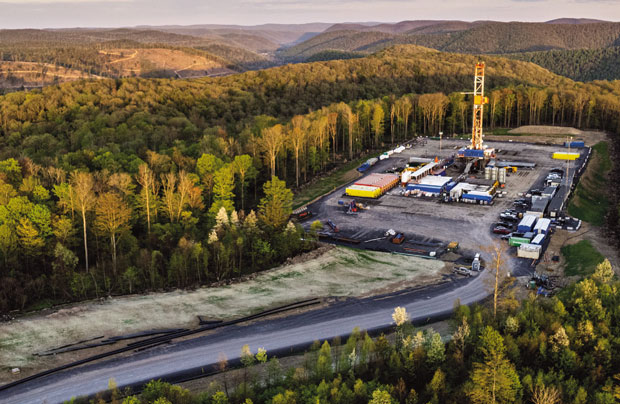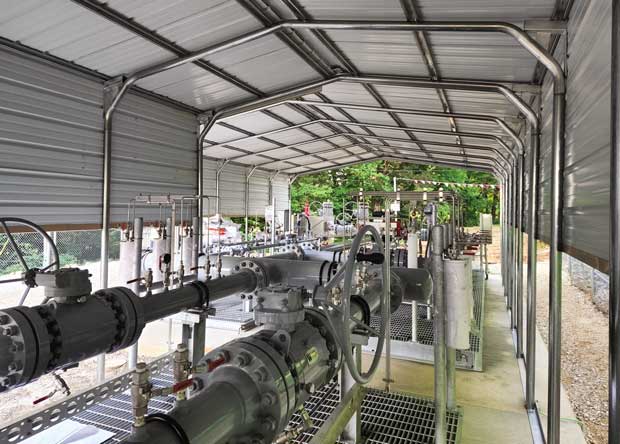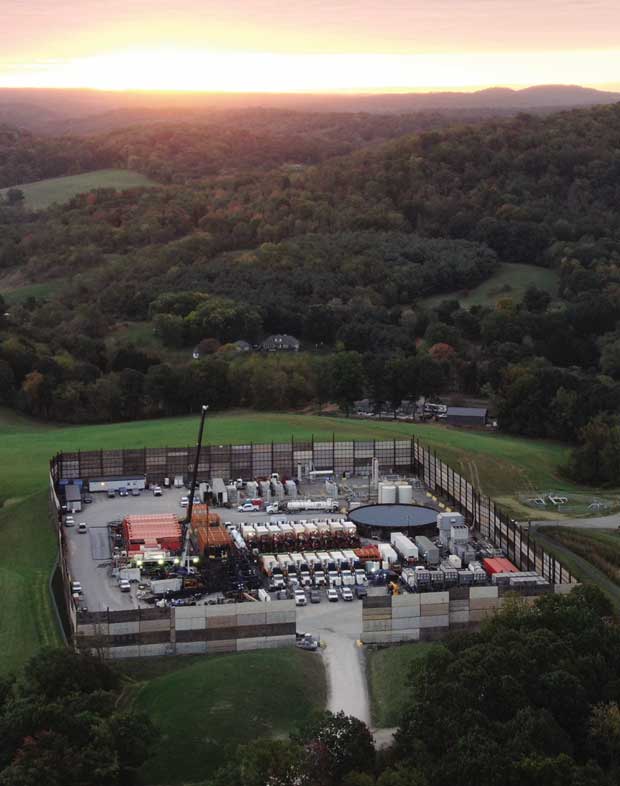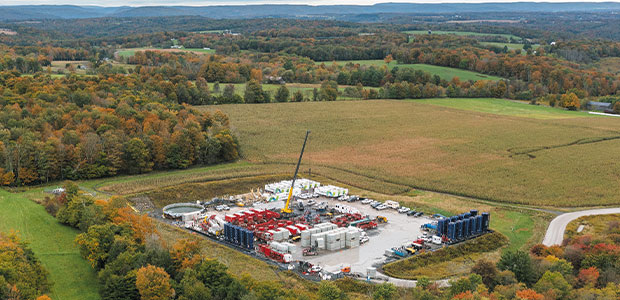
Appalachian Producers Eye Improving Fundamentals, Growing Demand Sectors
By Danny Boyd
With the winter heating season now on the horizon, is the tide about to turn and usher in an extended run of improved market dynamics for natural gas?
Producers in America’s largest gas shale province certainly hope so as they eye a number of factors that portend better days ahead. There is no question that the Appalachian Basin has the reserves locked in place in the Marcellus and Utica shales to supply incremental demand growth for years to come. The issue has been waiting on the call from the market to get more product in the pipeline.
Fundamentals may be about to signal the time for exactly that, aligning the near-term demand pull for winter heating with a big intermediate-term step up in liquified natural gas export volumes and forecasted strong long-term growth trends in gas-fired power generation to augment higher baseline natural gas consumption.
Proliferating artificial intelligence data centers, with row after row of power-hungry processors and servers, are a big reason for the anticipated sharp rise in electric generation demand. Natural gas is expected to account for sizeable share of the generation mix, according to the EIA, and Appalachian producers are quick to point out that the Marcellus and Utica are ideally positioned to supply the molecules of gas to generate the electrons of power required to feed an expansive data center infrastructure from upper New England southward to the lower Atlantic seaboard.
Already, some operators are fielding calls from data center representatives in search of a dependable solution to their power needs. Appalachian operators have the perfect answer: secure, reliable and locally produced natural gas. Layer in the broader impact of a near doubling of LNG exports in the months ahead and Appalachia companies producing as much as 35 billion cubic feet a day have reason to be optimistic.
Power Player
Keeping an eye on the potential impact of winter weather, Josh Viets, chief operating officer at Expand Energy Corp., anticipates a broad tightening of market fundamentals in 2025 and beyond amid a confluence of conditions. On the supply side, producers have trimmed output, and on the demand side a projected 80% increase in LNG exports over five years will boost returns, even in takeaway-constrained Appalachia, he says.
Expand Energy Corp. was formed from the merger of two Marcellus and Utica shale pioneers, Chesapeake Energy and Southwestern Energy. As one of Appalachia’s largest producers, Expand Energy operates 1.2 million acres in Pennsylvania, West Virginia and Ohio.
Some questions remain about actual macro demand at AI data centers dictated by the pace of construction and energy choices made by high-tech companies, but those power needs will make a sizable contribution, Viets assures.
Formed from the merger of Chesapeake Energy and Southwestern Energy, Expand enjoys the marketing advantage of selling about half its production outside Appalachia. In basin, the Oklahoma City-based company is busy courting relationships to bolster sales from production across 1.2 million acres in Pennsylvania, West Virginia and Ohio.
Operationally, Viets says Expand is improving drilling and completions by applying analytics honed in the Haynesville Shale to optimize well placement, drilling and well performance.
One model allows the team to monitor the mechanical condition and performance of the bottom-hole assembly and avoid unnecessary pipe trips. Another, combined with machine learning, helps place wells and predict production performance within 2% of actual measured results.
“That gives the engineers an opportunity to iterate and come up with the best combination of location, landing depths, and completion designs to create the most economic outcome for that particular well,” Viets explains.
Innovations are helping the drilling team set records, he adds, including the highest average footage per day achieved across a quarter, 1,675 feet, even with a program that had lateral lengths 15% shorter than the quarter before it.
“There is a strong correlation between lateral length and footage per day,” Viets comments. “Your next lateral foot is always more efficient than the prior one, so the fact that we set a record on footage per day with shorter laterals is pretty phenomenal.”
The merger came with Southwestern’s substantial position in the liquids phase of the Ohio Marcellus and Utica, where Expand plans to increase efforts to further diversify its portfolio, he says. “We are pleased to have liquids back in our portfolio and we see the Utica and Marcellus offering upside for future development.”
Operational Shift
Attractive oil, NGL and dry-gas wells are getting the attention of Ohio players and others eager to tap the Utica’s hydrocarbon treasure trove. To guide a shift to non-operator in the Utica, Sound Energy Company Inc. is leveraging a mostly conventional operated position, says company President Bruce Levengood.
Shifting to a non-operator position in the Utica Shale, Sound Energy Co. is leveraging a mostly conventional operated position that includes 650 wells across 18 counties, making it one of the Buckeye State’s larger producers.
The Dover, Oh.-based company, which Levengood oversees with his wife, sons, and a daughter, operates one Utica pad purchased in Harrison County in March of 2023. An operated conventional position includes 650 wells across 18 counties. Among the Buckeye State’s larger producers, Sound Energy last year produced 41,680 barrels of oil and 876 million cubic feet of gas.
Seeking Utica opportunities funded from cash flow, Levengood says eventual improvements in gas prices should reinforce buyer interest in the conventional position assembled chiefly through acquisitions since Levengood founded Sound Energy in 1992 following the sale of Atwood Resources Inc.
Conventional wells tap the Clinton Sand, which shallows moving from east to west, from about 5,700 feet in Harrison County to closer to 3,000 feet in Licking County, Levengood notes. The non-monolithic sand consists of varying layers of rock across the interval that can contribute to different hydrocarbon mixes among adjacent wells, he adds.
With the Utica offering the potential for higher returns, an acrimonious regulatory environment favored by industry opponents across the country is a major motivator to make the change, Levengood says.
“We are beginning this new venture,” he says. “We have eased into it slowly, but we will be ramping that up.”
Acquisition Strategy
Acreage in the liquids phases of the Ohio Utica is like money in the bank for Diversified Energy Co., says Senior Vice President Douglas Kris.
Instead of growing through the drill bit, Diversified, founded by West Virginia native Rusty Hutson Jr., continues to acquire mature assets and extend production life. Appalachia production accounts for about half of 850 MMcf equivalent of daily output, with upstream operations supplemented by a midstream position, gas marketing and a well retirement company, Next LVL.
Diversified Energy Co. is focused on acquiring mature assets and extending their production lives by leveraging technology and data science to improve efficiency. Acquired assets include Utica acreage prospective for both oil and NGL-rich gas to boost upstream and midstream performance.
Acquired assets include Utica acreage prospective of oil and gas liquids that can be easily divested for the right price, Kris says.
Of late, assets have been added in three transactions in East Texas and Oklahoma, but more opportunity lies ahead in Appalachia as merging companies divest of non-core and maturing assets, he remarks.
“From a strategic standpoint, we are well positioned to be the consolidator of those assets,” Kris states. “We can bring them into a portfolio and manage them under a modern field management philosophy that leverages technology and data to improve the efficiency all the way to the end of the well life.”
In the meantime, the company continues to use the latest technologies and analytics to track well history, performance and profitability and identify workover designs that range from $5,000 to $20,000 per well. Applications can include tubing or something as simple as soap sticks, he reports.
“Appalachian wells can have long-term decline ranges of 4.5%- 5%, so it does not take a lot to offset those declines,” Kris explains. “We have had a 12-month period where we did a number of these workovers and small-dollar care and maintenance items, and improved production without making any acquisitions.”
Diversified’s gas production already supplies utilities in West Virginia, he says, but the company is optimistic about prospects to supply additional Appalachia gas demand from AI data centers in the region that includes existing sites and new ones anticipated in Pennsylvania, West Virginia and Kentucky.
Selling Outside The Basin
In the near term, gas demand and pricing will increase with the only uncertainty being the timing of meeting more demand with ample supply from Appalachia and elsewhere, says Justin Loweth, president of Seneca Resources LLC and sister company, National Fuel Gas Midstream, both subsidiaries of National Fuel Gas Co.
Although timing is expected to contribute to some market volatility ahead, Seneca expects to benefit from locked-in prices and NYMEX-indexed values by selling 90% of its gas out of the basin, he reports.
Seneca Resources LLC and its sister company, National Fuel Gas Midstream (both subsidiaries of National Fuel Gas Co.), are marketing 90% of their Appalachian gas production outside of the basin, benefitting from locked-in prices and NYMEX-indexed values.
The company produces more than 1.1 Bcf net per day from a 1.2 million net-acre position in Pennsylvania that includes 850,000 fee acres on which Seneca owns all mineral interests and therefore pays no royalties and faces no lease expirations.
On pace to drill as many as 28 wells a year and holding more than a decade of drilling inventory, Seneca anticipates single-digit production growth running one-two rigs and a frac crew, Loweth says.
An eastern operating position includes 200 Utica and 100 Marcellus locations in Tioga and Lycoming counties identified from detailed 3-D seismic across the footprint.
Seneca is focusing mostly on the dry gas Utica in Tioga County, where restricted wells continue to flow 20 MMcf/d-30 MMcf/d months after completion from a bench 300-330 feet thick.
Plans for 2025 include Utica laterals ranging from 13,000-14,000 feet in length about 10,000-11,000 feet down. The team continues to set internal records that include 5,000 feet of lateral drilled in the Utica over a 24-hour period, Loweth points out.
The company’s western development area includes Cameron, Elk and McKean, where the company holds 925,000 acres, including 500,000 acres in Elk County with 300,000 fee acres.
Seneca’s ability to shift drilling from its western development area to the eastern area has allowed it to gain almost twice as much production per well at a time when productivity per 1,000 feet of lateral is declining nationally, Loweth points out.
“When we think about capital efficiency, if it costs us the same amount of money to drill and complete that 1,000 feet of lateral and we are getting twice as much gas, capital efficiency is through the roof,” he says. “In our case, it is about 20% more expensive to develop that 1,000 feet of lateral, but we are getting 100% more gas.”
Since the addition of Shell’s upstream and midstream assets in 2020 and an exit from California two years later, Seneca and NFG Midstream have continued to grow. One of three asset acquisitions added last year included the purchase of Southwestern Energy assets in northwest Tioga County.
While keeping an eye out for more potential deals, the company is building joint venture partnerships with adjacent operators to achieve what Loweth describes as “one plus one equals three” opportunities with lower costs and higher returns for each party.
Midstream Expertise
While discussing sales of its production to data centers, Appalachia and Rockies producer Greylock Energy Co. continues to expand a midstream service to industrial customers in need of Appalachia’s abundant, inexpensive gas, says Chief Executive Officer Kyle Mork.
Greylock Energy Co. is expanding its midstream services to industrial customers in need of natural gas supplies. Systems consist of connections, pipe, compression and equipment to regulate pressure and temperature. Clients include a steel mill near Louisville, Ky., and an electric vehicle battery manufacturer in the Southeast.
At its founding in 2017, the Charleston, W.V.-headquartered company operated and later sold a gas pipeline serving a power plant that had been converted from coal to gas. Soon, the company embarked on a midstream model giving industrial customers access to ready-to-use gas from interstate pipelines. Systems consist of connections, pipe, compression and equipment to regulate pressure and temperature. Clients include a leading regional steel mill near Louisville, Ky., and an electric vehicle battery manufacturer in the Southeast.
“We are spending the capital and have a contractual arrangement over a number of years in which clients pay for the gas and transportation to their doorstep,” Mork says.
Although industrial users are not consuming Greylock’s gas production, the company is weighing options to supply its own gas to regional data centers and others.
“We have had a lot of conversations with data center providers basically asking if we can provide them with a certain amount of gas over time so they can put natural gas generation on site and behind the meter to supply power,” he comments.
Some prospective clients will require multiple gigawatts of power higher than some large gas-fired power plants that generate 1-1.5 GW of power. Smaller data centers have discussed using smaller gas fuel cells, Mork says.
Renewables alone cannot provide enough energy to power data centers 24 hours a day, 365 days a year, he insists. Gas-fired generation has the inherent advantage of being able to be added quickly to meet demand surges.
“With U.S. power demand in general, we tend to be additive, meaning we may add more generating capacity, but we usually do not stop using what we are already using,” Mork says. “Our view is if these projects begin using gas, they will likely continue to use gas long term.”
Growing Organically
Relying solely on organic growth, Olympus Energy LLC in Canonsburg, Pa., has built a 100,000 net-acre position with a 20+ year drilling inventory in Westmoreland and Allegheny counties in southwestern Pennsylvania prospective of the Marcellus, Utica, and Upper Devonian, according to Chief Operating Officer Michael Wahl.
Current production of about 500 MMcf/d comes from less than 90 wells serviced by its subsidiary, Hyperion Midstream. With an extensive runway of Marcellus prospects, Olympus also has been busy proving up the deeper Utica, Wahl says.
Olympus Energy LLC has amassed a 100,000 net-acre position with a 20+ year drilling inventory in Westmoreland and Allegheny counties in southwestern Pennsylvania prospective for the Marcellus, Utica, and Upper Devonian. The company continues to push lateral lengths to beyond 24,000 feet in some cases.
“The Olympus team, to its credit, has become a leader developing the deep, dry Utica,” he remarks. “We have a successful delineation program in place that has unlocked another world-class resource. When we add this prolific Utica development to the existing core Marcellus portfolio, that runway of growth opportunities and inventory extends even farther.”
The company continues to push lateral lengths, including some beyond 24,000 feet. While completions in the Marcellus have become more uniform, Olympus continues to experiment in the Utica with proppant intensity, spacing and perforation designs, Wahl explains.
Initially formed as Huntley & Huntley Energy Exploration from a partnership between Blackstone and Huntley & Huntley Inc., the private company launched land leasing efforts in 2012, assembled an operating team beginning in 2016, drilled its first wells in 2018, and rebranded to Olympus in 2019 to better reflect its vision for the future.
In addition to innovations downhole, Olympus continues to make surface advancements, including switching to electric and dual-fuel frac fleets, mitigating truck traffic on the roads by piping freshwater, recycling virtually all of its water, and stepping up emissions monitoring, Wahl relates.
While currently marketing the majority of its output in basin, the company also is actively discussing sales possibilities with data center companies, Wahl says.
“The market for data center demand is in the early stages of development, but we are part of the conversation with that industry right now and trying to get a better picture of what that looks like, where the opportunities lie, and where we fit into those plans on the supply side,” he concludes.
For other great articles about exploration, drilling, completions and production, subscribe to The American Oil & Gas Reporter and bookmark www.aogr.com.














